POLS 1123: A Study of Regional Economic Development Policy in Canada
VerifiedAdded on 2023/04/21
|9
|2266
|61
Essay
AI Summary
This essay explores the complexities of regional economic development policy implementation in North-western Ontario, Canada, a socioeconomically disadvantaged region. It highlights the challenges of intergovernmental associations, particularly the exclusion of municipal governments, and the demographic and economic issues facing the region. The essay discusses the role of FedNor in promoting economic development and the initiatives of the North-western Ontario Municipal Association (NOMA) in establishing strategic associations and policy infrastructure. It emphasizes the importance of partnerships between various levels of government, community organizations, and the private sector to address regional economic decline and promote sustainable development. The analysis concludes that agencies like FedNor play a crucial role in coordinating efforts and facilitating collaboration to support regional and local community growth.

Running head: POLITICAL SCIENCE
POLITICAL SCIENCE
Name of the Student:
Name of the University:
Author note:
POLITICAL SCIENCE
Name of the Student:
Name of the University:
Author note:
Paraphrase This Document
Need a fresh take? Get an instant paraphrase of this document with our AI Paraphraser
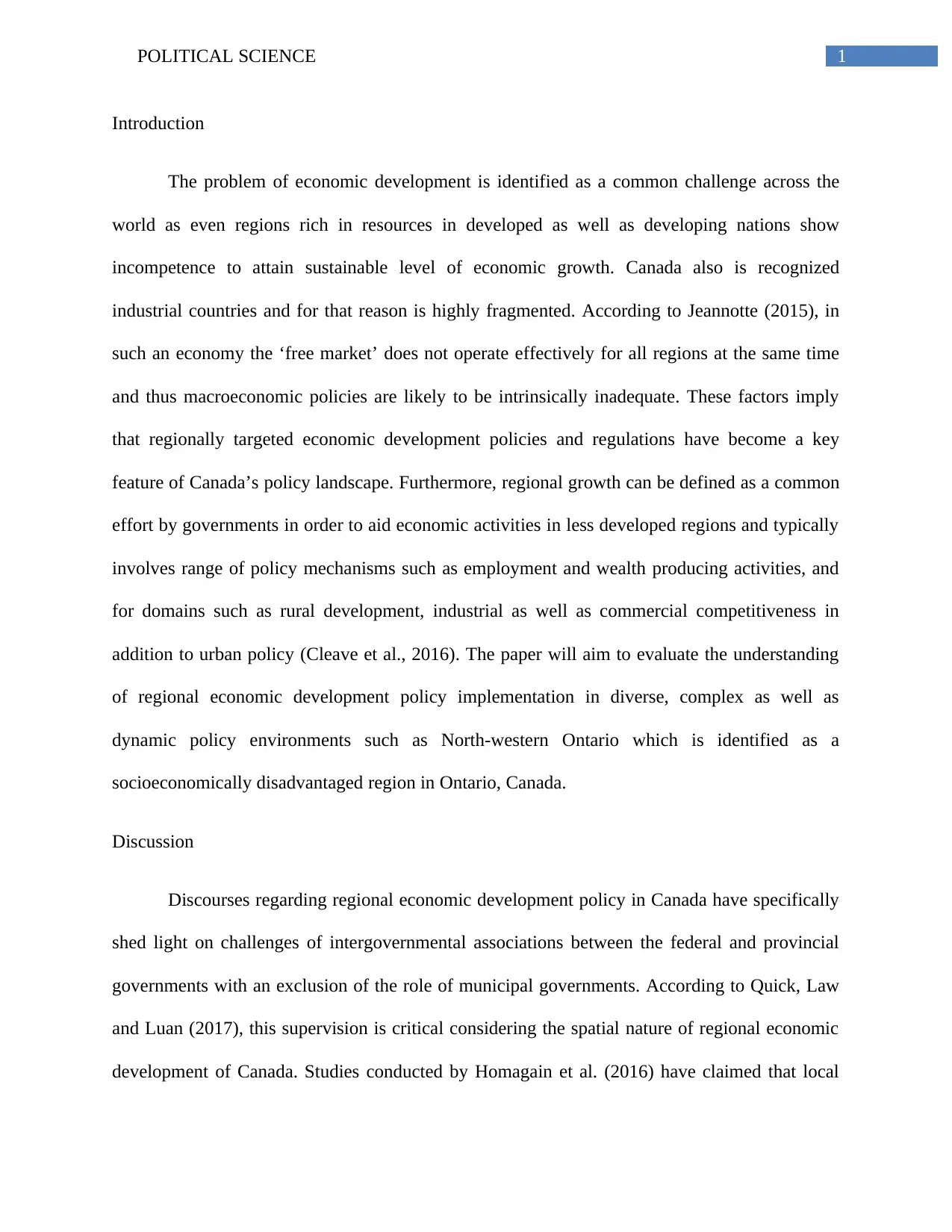
1POLITICAL SCIENCE
Introduction
The problem of economic development is identified as a common challenge across the
world as even regions rich in resources in developed as well as developing nations show
incompetence to attain sustainable level of economic growth. Canada also is recognized
industrial countries and for that reason is highly fragmented. According to Jeannotte (2015), in
such an economy the ‘free market’ does not operate effectively for all regions at the same time
and thus macroeconomic policies are likely to be intrinsically inadequate. These factors imply
that regionally targeted economic development policies and regulations have become a key
feature of Canada’s policy landscape. Furthermore, regional growth can be defined as a common
effort by governments in order to aid economic activities in less developed regions and typically
involves range of policy mechanisms such as employment and wealth producing activities, and
for domains such as rural development, industrial as well as commercial competitiveness in
addition to urban policy (Cleave et al., 2016). The paper will aim to evaluate the understanding
of regional economic development policy implementation in diverse, complex as well as
dynamic policy environments such as North-western Ontario which is identified as a
socioeconomically disadvantaged region in Ontario, Canada.
Discussion
Discourses regarding regional economic development policy in Canada have specifically
shed light on challenges of intergovernmental associations between the federal and provincial
governments with an exclusion of the role of municipal governments. According to Quick, Law
and Luan (2017), this supervision is critical considering the spatial nature of regional economic
development of Canada. Studies conducted by Homagain et al. (2016) have claimed that local
Introduction
The problem of economic development is identified as a common challenge across the
world as even regions rich in resources in developed as well as developing nations show
incompetence to attain sustainable level of economic growth. Canada also is recognized
industrial countries and for that reason is highly fragmented. According to Jeannotte (2015), in
such an economy the ‘free market’ does not operate effectively for all regions at the same time
and thus macroeconomic policies are likely to be intrinsically inadequate. These factors imply
that regionally targeted economic development policies and regulations have become a key
feature of Canada’s policy landscape. Furthermore, regional growth can be defined as a common
effort by governments in order to aid economic activities in less developed regions and typically
involves range of policy mechanisms such as employment and wealth producing activities, and
for domains such as rural development, industrial as well as commercial competitiveness in
addition to urban policy (Cleave et al., 2016). The paper will aim to evaluate the understanding
of regional economic development policy implementation in diverse, complex as well as
dynamic policy environments such as North-western Ontario which is identified as a
socioeconomically disadvantaged region in Ontario, Canada.
Discussion
Discourses regarding regional economic development policy in Canada have specifically
shed light on challenges of intergovernmental associations between the federal and provincial
governments with an exclusion of the role of municipal governments. According to Quick, Law
and Luan (2017), this supervision is critical considering the spatial nature of regional economic
development of Canada. Studies conducted by Homagain et al. (2016) have claimed that local
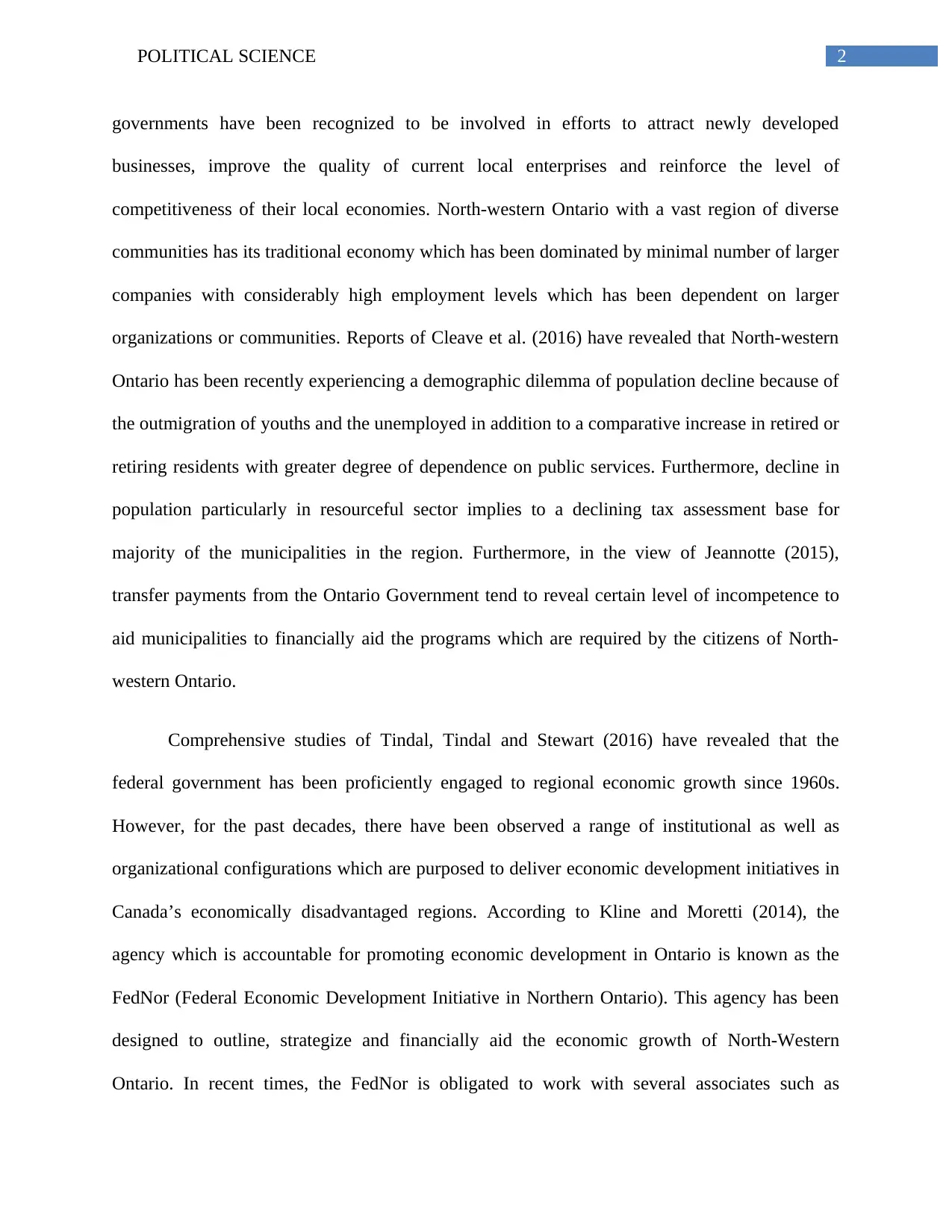
2POLITICAL SCIENCE
governments have been recognized to be involved in efforts to attract newly developed
businesses, improve the quality of current local enterprises and reinforce the level of
competitiveness of their local economies. North-western Ontario with a vast region of diverse
communities has its traditional economy which has been dominated by minimal number of larger
companies with considerably high employment levels which has been dependent on larger
organizations or communities. Reports of Cleave et al. (2016) have revealed that North-western
Ontario has been recently experiencing a demographic dilemma of population decline because of
the outmigration of youths and the unemployed in addition to a comparative increase in retired or
retiring residents with greater degree of dependence on public services. Furthermore, decline in
population particularly in resourceful sector implies to a declining tax assessment base for
majority of the municipalities in the region. Furthermore, in the view of Jeannotte (2015),
transfer payments from the Ontario Government tend to reveal certain level of incompetence to
aid municipalities to financially aid the programs which are required by the citizens of North-
western Ontario.
Comprehensive studies of Tindal, Tindal and Stewart (2016) have revealed that the
federal government has been proficiently engaged to regional economic growth since 1960s.
However, for the past decades, there have been observed a range of institutional as well as
organizational configurations which are purposed to deliver economic development initiatives in
Canada’s economically disadvantaged regions. According to Kline and Moretti (2014), the
agency which is accountable for promoting economic development in Ontario is known as the
FedNor (Federal Economic Development Initiative in Northern Ontario). This agency has been
designed to outline, strategize and financially aid the economic growth of North-Western
Ontario. In recent times, the FedNor is obligated to work with several associates such as
governments have been recognized to be involved in efforts to attract newly developed
businesses, improve the quality of current local enterprises and reinforce the level of
competitiveness of their local economies. North-western Ontario with a vast region of diverse
communities has its traditional economy which has been dominated by minimal number of larger
companies with considerably high employment levels which has been dependent on larger
organizations or communities. Reports of Cleave et al. (2016) have revealed that North-western
Ontario has been recently experiencing a demographic dilemma of population decline because of
the outmigration of youths and the unemployed in addition to a comparative increase in retired or
retiring residents with greater degree of dependence on public services. Furthermore, decline in
population particularly in resourceful sector implies to a declining tax assessment base for
majority of the municipalities in the region. Furthermore, in the view of Jeannotte (2015),
transfer payments from the Ontario Government tend to reveal certain level of incompetence to
aid municipalities to financially aid the programs which are required by the citizens of North-
western Ontario.
Comprehensive studies of Tindal, Tindal and Stewart (2016) have revealed that the
federal government has been proficiently engaged to regional economic growth since 1960s.
However, for the past decades, there have been observed a range of institutional as well as
organizational configurations which are purposed to deliver economic development initiatives in
Canada’s economically disadvantaged regions. According to Kline and Moretti (2014), the
agency which is accountable for promoting economic development in Ontario is known as the
FedNor (Federal Economic Development Initiative in Northern Ontario). This agency has been
designed to outline, strategize and financially aid the economic growth of North-Western
Ontario. In recent times, the FedNor is obligated to work with several associates such as
⊘ This is a preview!⊘
Do you want full access?
Subscribe today to unlock all pages.

Trusted by 1+ million students worldwide
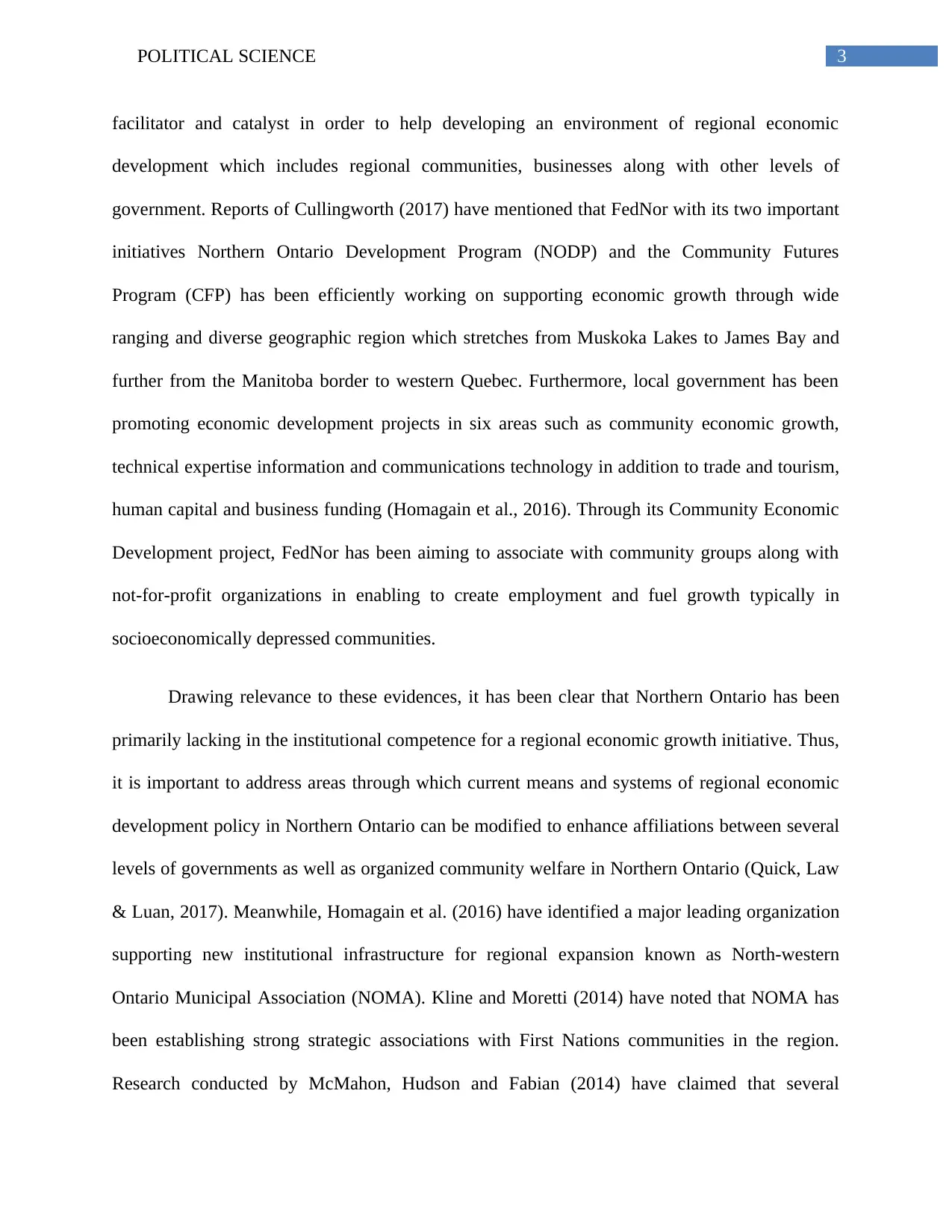
3POLITICAL SCIENCE
facilitator and catalyst in order to help developing an environment of regional economic
development which includes regional communities, businesses along with other levels of
government. Reports of Cullingworth (2017) have mentioned that FedNor with its two important
initiatives Northern Ontario Development Program (NODP) and the Community Futures
Program (CFP) has been efficiently working on supporting economic growth through wide
ranging and diverse geographic region which stretches from Muskoka Lakes to James Bay and
further from the Manitoba border to western Quebec. Furthermore, local government has been
promoting economic development projects in six areas such as community economic growth,
technical expertise information and communications technology in addition to trade and tourism,
human capital and business funding (Homagain et al., 2016). Through its Community Economic
Development project, FedNor has been aiming to associate with community groups along with
not-for-profit organizations in enabling to create employment and fuel growth typically in
socioeconomically depressed communities.
Drawing relevance to these evidences, it has been clear that Northern Ontario has been
primarily lacking in the institutional competence for a regional economic growth initiative. Thus,
it is important to address areas through which current means and systems of regional economic
development policy in Northern Ontario can be modified to enhance affiliations between several
levels of governments as well as organized community welfare in Northern Ontario (Quick, Law
& Luan, 2017). Meanwhile, Homagain et al. (2016) have identified a major leading organization
supporting new institutional infrastructure for regional expansion known as North-western
Ontario Municipal Association (NOMA). Kline and Moretti (2014) have noted that NOMA has
been establishing strong strategic associations with First Nations communities in the region.
Research conducted by McMahon, Hudson and Fabian (2014) have claimed that several
facilitator and catalyst in order to help developing an environment of regional economic
development which includes regional communities, businesses along with other levels of
government. Reports of Cullingworth (2017) have mentioned that FedNor with its two important
initiatives Northern Ontario Development Program (NODP) and the Community Futures
Program (CFP) has been efficiently working on supporting economic growth through wide
ranging and diverse geographic region which stretches from Muskoka Lakes to James Bay and
further from the Manitoba border to western Quebec. Furthermore, local government has been
promoting economic development projects in six areas such as community economic growth,
technical expertise information and communications technology in addition to trade and tourism,
human capital and business funding (Homagain et al., 2016). Through its Community Economic
Development project, FedNor has been aiming to associate with community groups along with
not-for-profit organizations in enabling to create employment and fuel growth typically in
socioeconomically depressed communities.
Drawing relevance to these evidences, it has been clear that Northern Ontario has been
primarily lacking in the institutional competence for a regional economic growth initiative. Thus,
it is important to address areas through which current means and systems of regional economic
development policy in Northern Ontario can be modified to enhance affiliations between several
levels of governments as well as organized community welfare in Northern Ontario (Quick, Law
& Luan, 2017). Meanwhile, Homagain et al. (2016) have identified a major leading organization
supporting new institutional infrastructure for regional expansion known as North-western
Ontario Municipal Association (NOMA). Kline and Moretti (2014) have noted that NOMA has
been establishing strong strategic associations with First Nations communities in the region.
Research conducted by McMahon, Hudson and Fabian (2014) have claimed that several
Paraphrase This Document
Need a fresh take? Get an instant paraphrase of this document with our AI Paraphraser
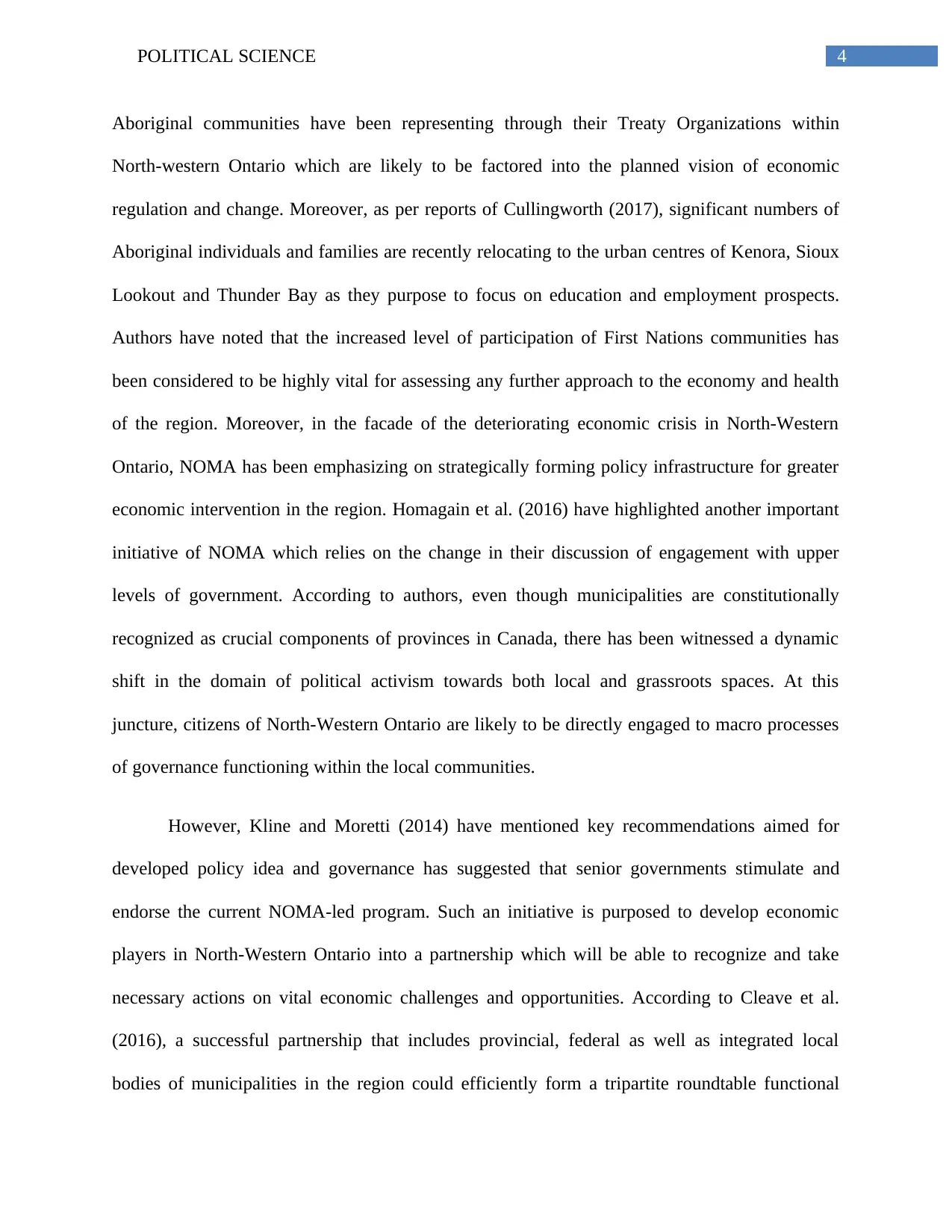
4POLITICAL SCIENCE
Aboriginal communities have been representing through their Treaty Organizations within
North-western Ontario which are likely to be factored into the planned vision of economic
regulation and change. Moreover, as per reports of Cullingworth (2017), significant numbers of
Aboriginal individuals and families are recently relocating to the urban centres of Kenora, Sioux
Lookout and Thunder Bay as they purpose to focus on education and employment prospects.
Authors have noted that the increased level of participation of First Nations communities has
been considered to be highly vital for assessing any further approach to the economy and health
of the region. Moreover, in the facade of the deteriorating economic crisis in North-Western
Ontario, NOMA has been emphasizing on strategically forming policy infrastructure for greater
economic intervention in the region. Homagain et al. (2016) have highlighted another important
initiative of NOMA which relies on the change in their discussion of engagement with upper
levels of government. According to authors, even though municipalities are constitutionally
recognized as crucial components of provinces in Canada, there has been witnessed a dynamic
shift in the domain of political activism towards both local and grassroots spaces. At this
juncture, citizens of North-Western Ontario are likely to be directly engaged to macro processes
of governance functioning within the local communities.
However, Kline and Moretti (2014) have mentioned key recommendations aimed for
developed policy idea and governance has suggested that senior governments stimulate and
endorse the current NOMA-led program. Such an initiative is purposed to develop economic
players in North-Western Ontario into a partnership which will be able to recognize and take
necessary actions on vital economic challenges and opportunities. According to Cleave et al.
(2016), a successful partnership that includes provincial, federal as well as integrated local
bodies of municipalities in the region could efficiently form a tripartite roundtable functional
Aboriginal communities have been representing through their Treaty Organizations within
North-western Ontario which are likely to be factored into the planned vision of economic
regulation and change. Moreover, as per reports of Cullingworth (2017), significant numbers of
Aboriginal individuals and families are recently relocating to the urban centres of Kenora, Sioux
Lookout and Thunder Bay as they purpose to focus on education and employment prospects.
Authors have noted that the increased level of participation of First Nations communities has
been considered to be highly vital for assessing any further approach to the economy and health
of the region. Moreover, in the facade of the deteriorating economic crisis in North-Western
Ontario, NOMA has been emphasizing on strategically forming policy infrastructure for greater
economic intervention in the region. Homagain et al. (2016) have highlighted another important
initiative of NOMA which relies on the change in their discussion of engagement with upper
levels of government. According to authors, even though municipalities are constitutionally
recognized as crucial components of provinces in Canada, there has been witnessed a dynamic
shift in the domain of political activism towards both local and grassroots spaces. At this
juncture, citizens of North-Western Ontario are likely to be directly engaged to macro processes
of governance functioning within the local communities.
However, Kline and Moretti (2014) have mentioned key recommendations aimed for
developed policy idea and governance has suggested that senior governments stimulate and
endorse the current NOMA-led program. Such an initiative is purposed to develop economic
players in North-Western Ontario into a partnership which will be able to recognize and take
necessary actions on vital economic challenges and opportunities. According to Cleave et al.
(2016), a successful partnership that includes provincial, federal as well as integrated local
bodies of municipalities in the region could efficiently form a tripartite roundtable functional
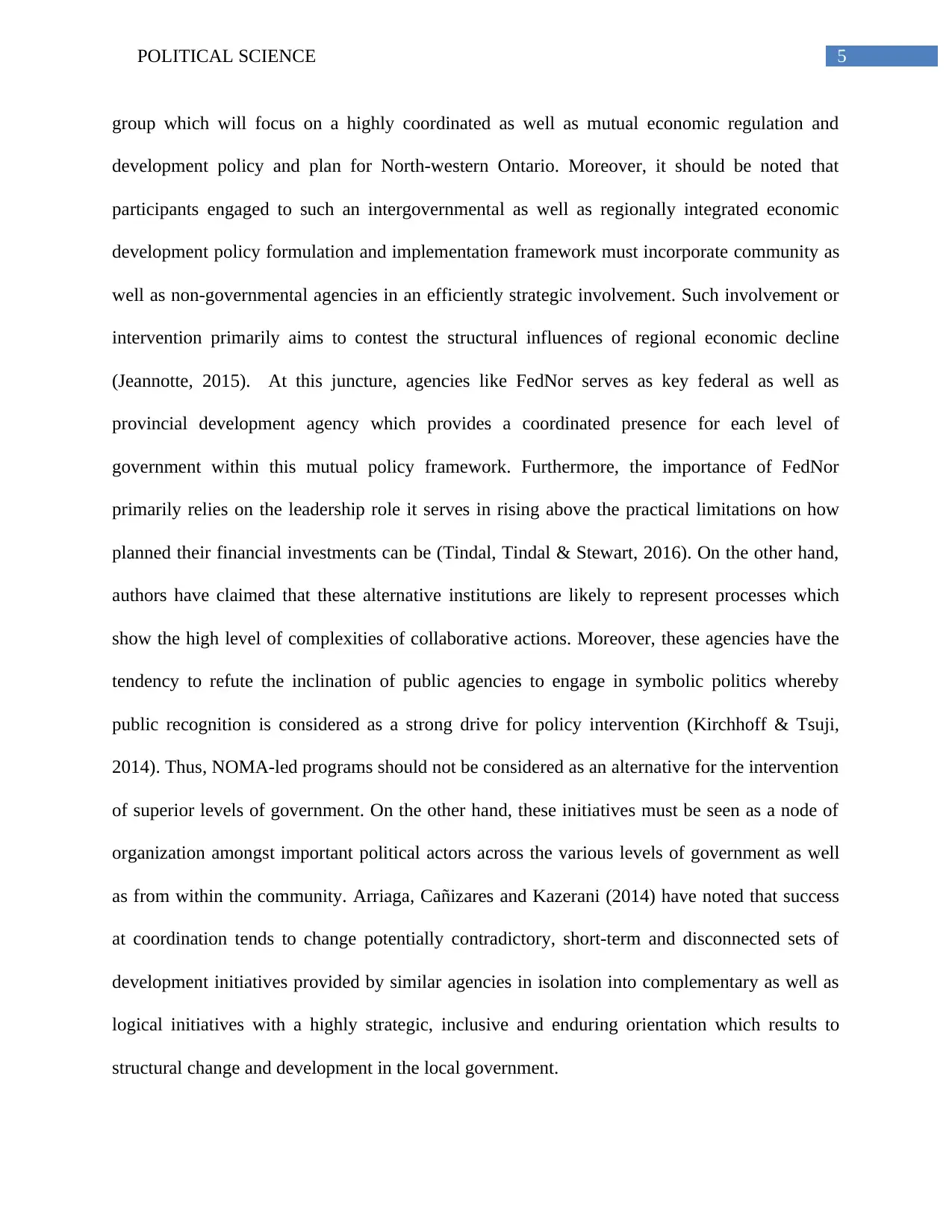
5POLITICAL SCIENCE
group which will focus on a highly coordinated as well as mutual economic regulation and
development policy and plan for North-western Ontario. Moreover, it should be noted that
participants engaged to such an intergovernmental as well as regionally integrated economic
development policy formulation and implementation framework must incorporate community as
well as non-governmental agencies in an efficiently strategic involvement. Such involvement or
intervention primarily aims to contest the structural influences of regional economic decline
(Jeannotte, 2015). At this juncture, agencies like FedNor serves as key federal as well as
provincial development agency which provides a coordinated presence for each level of
government within this mutual policy framework. Furthermore, the importance of FedNor
primarily relies on the leadership role it serves in rising above the practical limitations on how
planned their financial investments can be (Tindal, Tindal & Stewart, 2016). On the other hand,
authors have claimed that these alternative institutions are likely to represent processes which
show the high level of complexities of collaborative actions. Moreover, these agencies have the
tendency to refute the inclination of public agencies to engage in symbolic politics whereby
public recognition is considered as a strong drive for policy intervention (Kirchhoff & Tsuji,
2014). Thus, NOMA-led programs should not be considered as an alternative for the intervention
of superior levels of government. On the other hand, these initiatives must be seen as a node of
organization amongst important political actors across the various levels of government as well
as from within the community. Arriaga, Cañizares and Kazerani (2014) have noted that success
at coordination tends to change potentially contradictory, short-term and disconnected sets of
development initiatives provided by similar agencies in isolation into complementary as well as
logical initiatives with a highly strategic, inclusive and enduring orientation which results to
structural change and development in the local government.
group which will focus on a highly coordinated as well as mutual economic regulation and
development policy and plan for North-western Ontario. Moreover, it should be noted that
participants engaged to such an intergovernmental as well as regionally integrated economic
development policy formulation and implementation framework must incorporate community as
well as non-governmental agencies in an efficiently strategic involvement. Such involvement or
intervention primarily aims to contest the structural influences of regional economic decline
(Jeannotte, 2015). At this juncture, agencies like FedNor serves as key federal as well as
provincial development agency which provides a coordinated presence for each level of
government within this mutual policy framework. Furthermore, the importance of FedNor
primarily relies on the leadership role it serves in rising above the practical limitations on how
planned their financial investments can be (Tindal, Tindal & Stewart, 2016). On the other hand,
authors have claimed that these alternative institutions are likely to represent processes which
show the high level of complexities of collaborative actions. Moreover, these agencies have the
tendency to refute the inclination of public agencies to engage in symbolic politics whereby
public recognition is considered as a strong drive for policy intervention (Kirchhoff & Tsuji,
2014). Thus, NOMA-led programs should not be considered as an alternative for the intervention
of superior levels of government. On the other hand, these initiatives must be seen as a node of
organization amongst important political actors across the various levels of government as well
as from within the community. Arriaga, Cañizares and Kazerani (2014) have noted that success
at coordination tends to change potentially contradictory, short-term and disconnected sets of
development initiatives provided by similar agencies in isolation into complementary as well as
logical initiatives with a highly strategic, inclusive and enduring orientation which results to
structural change and development in the local government.
⊘ This is a preview!⊘
Do you want full access?
Subscribe today to unlock all pages.

Trusted by 1+ million students worldwide
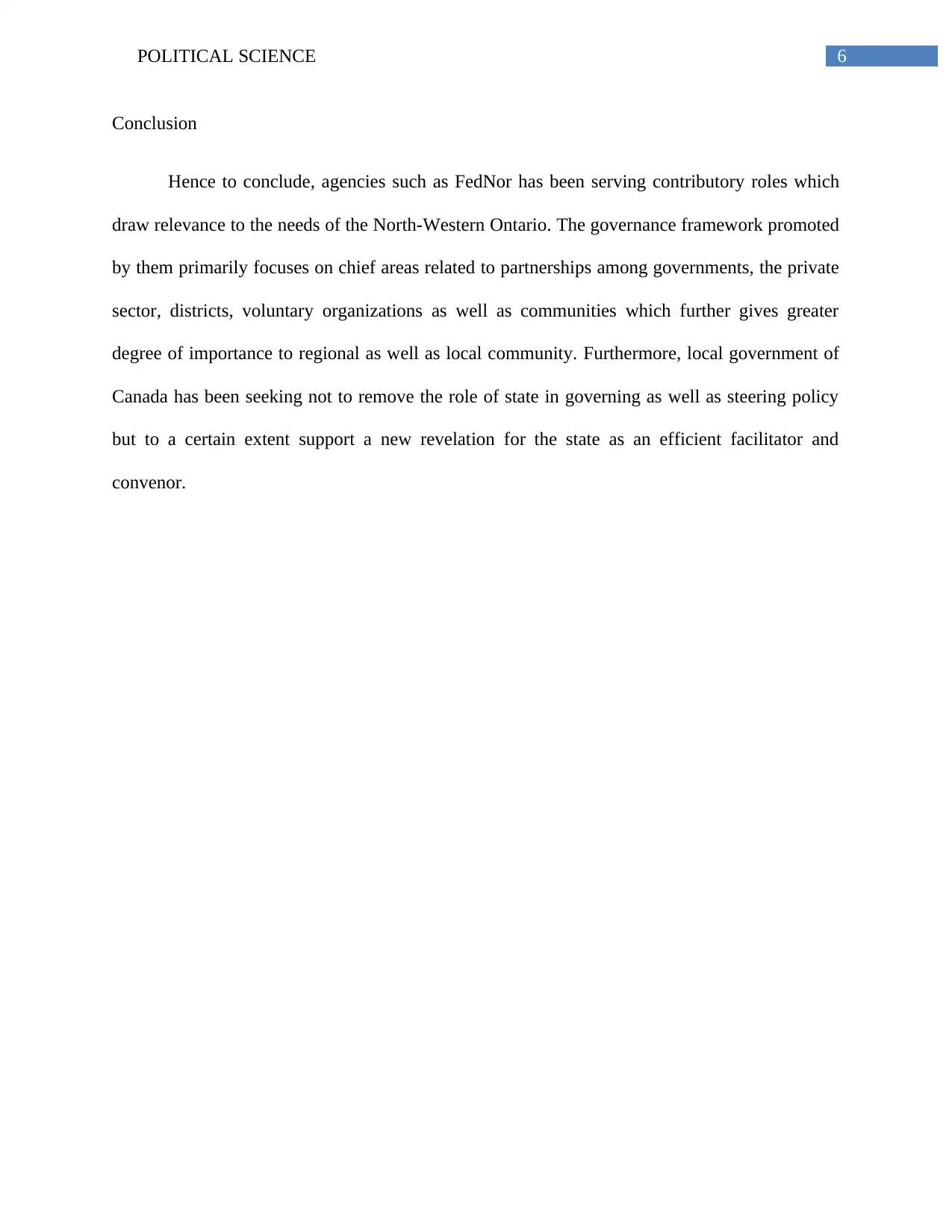
6POLITICAL SCIENCE
Conclusion
Hence to conclude, agencies such as FedNor has been serving contributory roles which
draw relevance to the needs of the North-Western Ontario. The governance framework promoted
by them primarily focuses on chief areas related to partnerships among governments, the private
sector, districts, voluntary organizations as well as communities which further gives greater
degree of importance to regional as well as local community. Furthermore, local government of
Canada has been seeking not to remove the role of state in governing as well as steering policy
but to a certain extent support a new revelation for the state as an efficient facilitator and
convenor.
Conclusion
Hence to conclude, agencies such as FedNor has been serving contributory roles which
draw relevance to the needs of the North-Western Ontario. The governance framework promoted
by them primarily focuses on chief areas related to partnerships among governments, the private
sector, districts, voluntary organizations as well as communities which further gives greater
degree of importance to regional as well as local community. Furthermore, local government of
Canada has been seeking not to remove the role of state in governing as well as steering policy
but to a certain extent support a new revelation for the state as an efficient facilitator and
convenor.
Paraphrase This Document
Need a fresh take? Get an instant paraphrase of this document with our AI Paraphraser
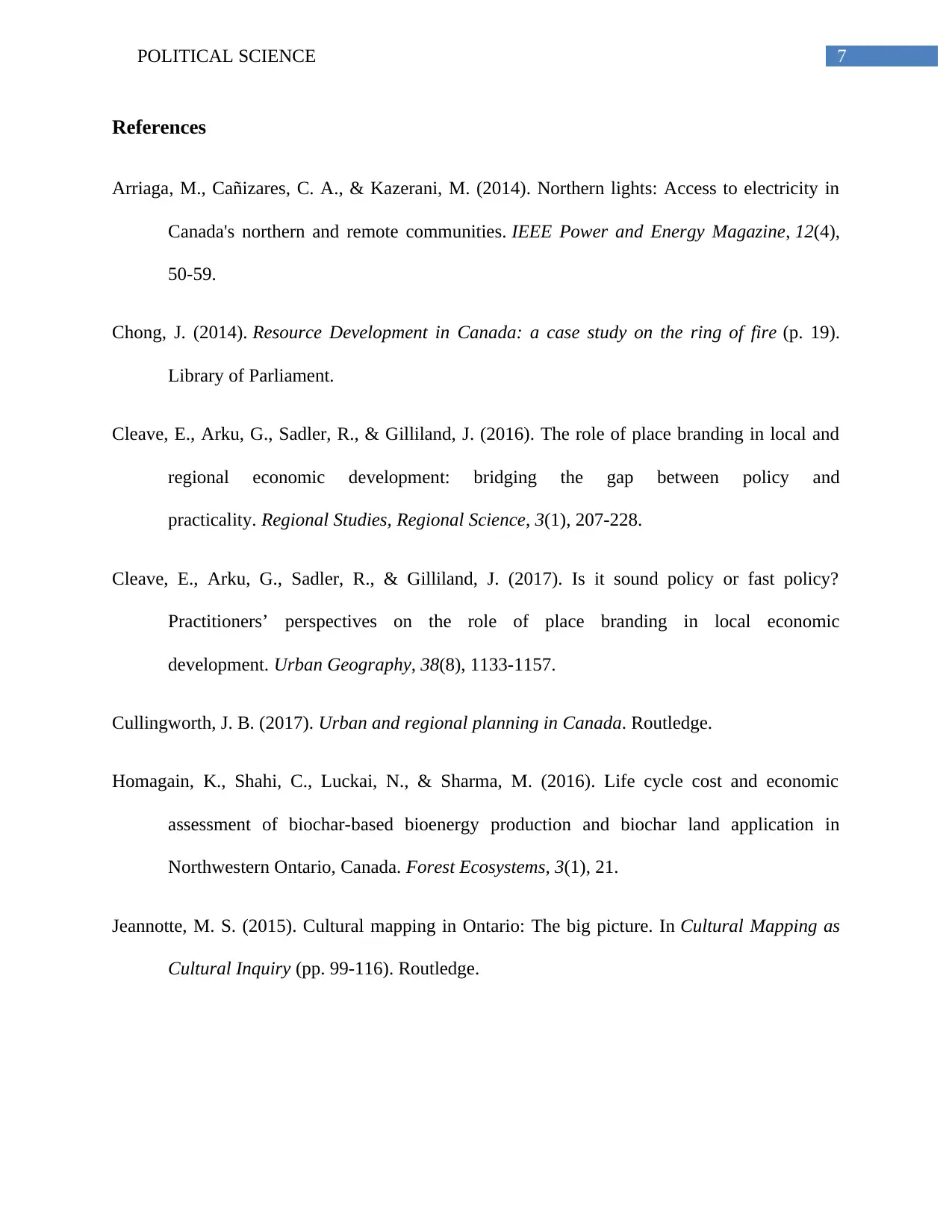
7POLITICAL SCIENCE
References
Arriaga, M., Cañizares, C. A., & Kazerani, M. (2014). Northern lights: Access to electricity in
Canada's northern and remote communities. IEEE Power and Energy Magazine, 12(4),
50-59.
Chong, J. (2014). Resource Development in Canada: a case study on the ring of fire (p. 19).
Library of Parliament.
Cleave, E., Arku, G., Sadler, R., & Gilliland, J. (2016). The role of place branding in local and
regional economic development: bridging the gap between policy and
practicality. Regional Studies, Regional Science, 3(1), 207-228.
Cleave, E., Arku, G., Sadler, R., & Gilliland, J. (2017). Is it sound policy or fast policy?
Practitioners’ perspectives on the role of place branding in local economic
development. Urban Geography, 38(8), 1133-1157.
Cullingworth, J. B. (2017). Urban and regional planning in Canada. Routledge.
Homagain, K., Shahi, C., Luckai, N., & Sharma, M. (2016). Life cycle cost and economic
assessment of biochar-based bioenergy production and biochar land application in
Northwestern Ontario, Canada. Forest Ecosystems, 3(1), 21.
Jeannotte, M. S. (2015). Cultural mapping in Ontario: The big picture. In Cultural Mapping as
Cultural Inquiry (pp. 99-116). Routledge.
References
Arriaga, M., Cañizares, C. A., & Kazerani, M. (2014). Northern lights: Access to electricity in
Canada's northern and remote communities. IEEE Power and Energy Magazine, 12(4),
50-59.
Chong, J. (2014). Resource Development in Canada: a case study on the ring of fire (p. 19).
Library of Parliament.
Cleave, E., Arku, G., Sadler, R., & Gilliland, J. (2016). The role of place branding in local and
regional economic development: bridging the gap between policy and
practicality. Regional Studies, Regional Science, 3(1), 207-228.
Cleave, E., Arku, G., Sadler, R., & Gilliland, J. (2017). Is it sound policy or fast policy?
Practitioners’ perspectives on the role of place branding in local economic
development. Urban Geography, 38(8), 1133-1157.
Cullingworth, J. B. (2017). Urban and regional planning in Canada. Routledge.
Homagain, K., Shahi, C., Luckai, N., & Sharma, M. (2016). Life cycle cost and economic
assessment of biochar-based bioenergy production and biochar land application in
Northwestern Ontario, Canada. Forest Ecosystems, 3(1), 21.
Jeannotte, M. S. (2015). Cultural mapping in Ontario: The big picture. In Cultural Mapping as
Cultural Inquiry (pp. 99-116). Routledge.
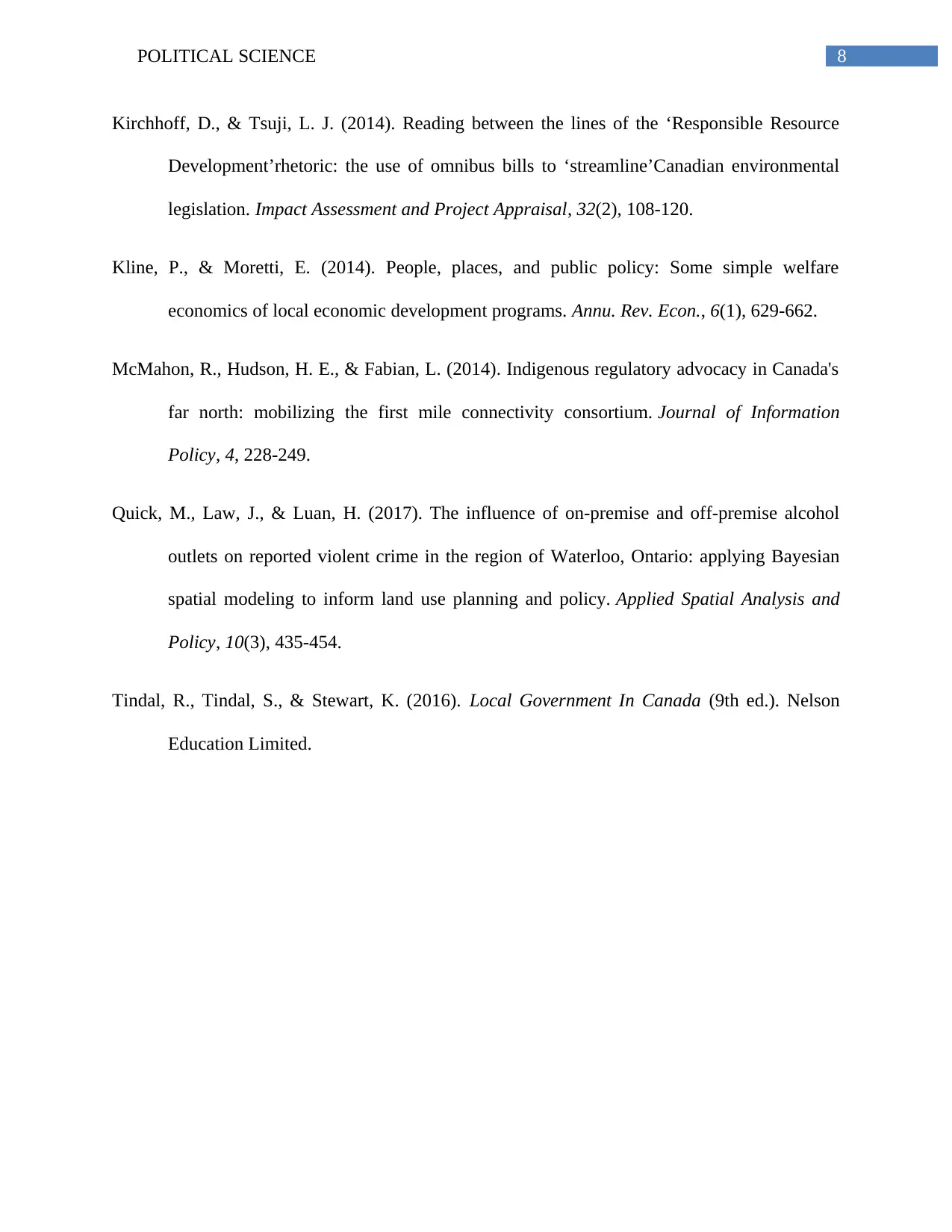
8POLITICAL SCIENCE
Kirchhoff, D., & Tsuji, L. J. (2014). Reading between the lines of the ‘Responsible Resource
Development’rhetoric: the use of omnibus bills to ‘streamline’Canadian environmental
legislation. Impact Assessment and Project Appraisal, 32(2), 108-120.
Kline, P., & Moretti, E. (2014). People, places, and public policy: Some simple welfare
economics of local economic development programs. Annu. Rev. Econ., 6(1), 629-662.
McMahon, R., Hudson, H. E., & Fabian, L. (2014). Indigenous regulatory advocacy in Canada's
far north: mobilizing the first mile connectivity consortium. Journal of Information
Policy, 4, 228-249.
Quick, M., Law, J., & Luan, H. (2017). The influence of on-premise and off-premise alcohol
outlets on reported violent crime in the region of Waterloo, Ontario: applying Bayesian
spatial modeling to inform land use planning and policy. Applied Spatial Analysis and
Policy, 10(3), 435-454.
Tindal, R., Tindal, S., & Stewart, K. (2016). Local Government In Canada (9th ed.). Nelson
Education Limited.
Kirchhoff, D., & Tsuji, L. J. (2014). Reading between the lines of the ‘Responsible Resource
Development’rhetoric: the use of omnibus bills to ‘streamline’Canadian environmental
legislation. Impact Assessment and Project Appraisal, 32(2), 108-120.
Kline, P., & Moretti, E. (2014). People, places, and public policy: Some simple welfare
economics of local economic development programs. Annu. Rev. Econ., 6(1), 629-662.
McMahon, R., Hudson, H. E., & Fabian, L. (2014). Indigenous regulatory advocacy in Canada's
far north: mobilizing the first mile connectivity consortium. Journal of Information
Policy, 4, 228-249.
Quick, M., Law, J., & Luan, H. (2017). The influence of on-premise and off-premise alcohol
outlets on reported violent crime in the region of Waterloo, Ontario: applying Bayesian
spatial modeling to inform land use planning and policy. Applied Spatial Analysis and
Policy, 10(3), 435-454.
Tindal, R., Tindal, S., & Stewart, K. (2016). Local Government In Canada (9th ed.). Nelson
Education Limited.
⊘ This is a preview!⊘
Do you want full access?
Subscribe today to unlock all pages.

Trusted by 1+ million students worldwide
1 out of 9
Related Documents
Your All-in-One AI-Powered Toolkit for Academic Success.
+13062052269
info@desklib.com
Available 24*7 on WhatsApp / Email
![[object Object]](/_next/static/media/star-bottom.7253800d.svg)
Unlock your academic potential
Copyright © 2020–2025 A2Z Services. All Rights Reserved. Developed and managed by ZUCOL.





